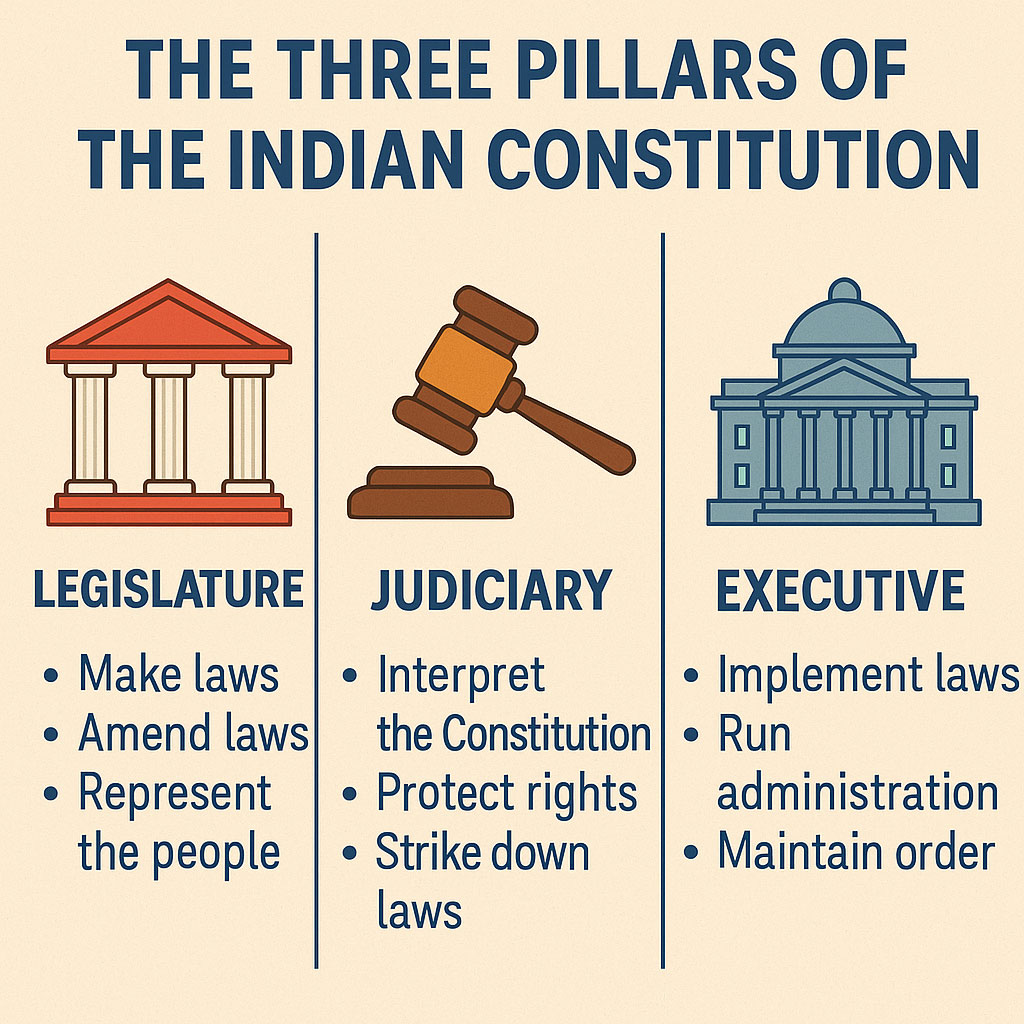If the Indian Constitution were directing a movie, it would proudly introduce its three superstar leads:
✨ The Legislature
⚖️ The Judiciary
🏛️ The Executive
Together, these three form the mighty Trinity of Indian Democracy, each with its own role, powers, and responsibilities—like the Avengers, but with fewer costumes and more paperwork.
Let’s break them down in a fun and super-simple way!
🏛️ 1. The Legislature – The Law-Makers (a.k.a. “The Think Tank”)
Think of the Legislature as the group that decides:
“What rules should the country follow?”
🔹 Who Are They?
- Parliament (Lok Sabha + Rajya Sabha)
- State Legislatures (Vidhan Sabha & sometimes Vidhan Parishad)
🔹 What Do They Do?
- Make new laws 👨💼✍️
- Change or remove old laws
- Approve budgets 💰
- Question the government (the Executive)
- Represent the people’s voice
🔹 Why Are They Important?
Without the Legislature, we’d have chaos.
Imagine driving without traffic rules—every day would be like a Fast & Furious movie.
⚖️ 2. The Judiciary – The Law-Interpreters (a.k.a. “The Referee”)
If laws are the rules of the game, the Judiciary is the referee who ensures fairness and stops foul play.
🔹 Who Are They?
- Supreme Court
- High Courts
- District & other subordinate courts
🔹 What Do They Do?
- Interpret the Constitution 🧐
- Protect fundamental rights
- Stop unconstitutional laws
- Settle disputes between states, people, and the government
- Act as the final guardian of justice
🔹 Superpower: Judicial Review
Courts can say:
“This law breaks the Constitution—REJECTED!”
Like a teacher striking out a wrong answer in bright red ink.
🏢 3. The Executive – The Law-Implementers (a.k.a. “The Action Team”)
These are the people who make sure everything actually happens on the ground.
🔹 Who Are They?
- President
- Prime Minister & Cabinet
- Government departments
- Police, civil services, district officers, etc.
🔹 What Do They Do?
- Run day-to-day administration
- Implement laws created by the Legislature
- Maintain law and order 🚓
- Handle foreign affairs
- Launch government schemes
- Manage public welfare
🔹 Why They Matter
Imagine if laws existed but nobody enforced them.
It would be like having house rules but no one to stop your sibling from stealing TV remote.
🤝 How They Work Together (Without Fighting… Most of the Time)
The beauty of Indian democracy is “checks and balances.”
- Legislature makes the laws
- Executive enforces the laws
- Judiciary reviews the laws
No one can become too powerful—just like a perfect team where everyone knows their job and nobody tries to be the boss of everyone else.
Dr. Ambedkar called this “the heart of democracy”.
🎉 Conclusion: The Three Pillars Keep India Standing Tall
The Legislature thinks,
the Executive acts,
and the Judiciary keeps everyone in line.
Together, they ensure that India remains a vibrant, democratic, rule-of-law-based nation.
Our Constitution didn’t just create three pillars—
it built a structure where power is shared, balanced, and accountable.
And that’s what keeps India’s democracy alive!

Leave a Reply